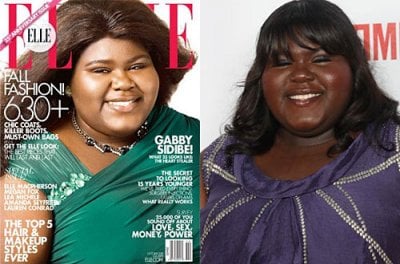
Natural Beauty for Minorities Undermined in Elle's Lightened Cover of Gabourey Sidibe
Posted on September 16, 2010, 12:55 PM
Are we different but equal? Or just different.


Photo Courtesy of: Elle Magazine & Getty Images
So when "Elle" magazine picked her to be one of their mid-twenties cover women for their honored 25th anniversary October issue, she was ecstatic. This would be the actress' first big fashion magazine cover.
However, Sidibe's natural beauty did not shine through as she looks drastically different on the cover.
Her skin is ... light.
Sidibe is significantly darker in the light of the day than on the cover as she has one of the darkest skin tones in Hollywood. The contrast is undeniably dramatic begging the staff of "Elle" the age-old question, is lighter skin more beautiful to you?
In addition, of the three other October "Elle" covers that will be on newsstands featuring actresses Amanda Seyfriend, Megan Fox and reality star Lauren Conrad, Sidibe's cover is awkwardly cropped into her face while the other covers have full body shots.
Why the separate treatment? It's a well known fact that magazines Photoshop and digitally alter their cover girls. Waists shrunken, thighs decreased, moles removed -- but is lighter skin really considered a beauty upgrade? And is Sidibe's body considered not cover-worthy?
To be fair, this has happened many times before. Vogue lightened Beyonce's skin tone on their cover as well and the Vaseline Company has recently come under fire for their Facebook application that lightens Indian men's profile pictures.
The issue of minorities being underrepresented in America has been a reality since the country began doling out citizenship to non-Caucasians. And while it is true that the entertainment media, including fashion magazines, have perpetually sidestepped featuring minorities, the fact stands that though America has become a global icon for diversity, White people are still the strong majority.
According to the U.S. 2010 Census, our country's population is divided so: The Non-Hispanic White proportion of the total population has decreased to less than 72 percent. 13 percent is Black, 11 percent Hispanic and 4 percent Asian/Pacific Islander.
In Hollywood, racial minorities constitute even less percentiles.
Based on the Census figures, if the fashion magazines were to be truly equal in their coverage of our diverse population, 8.7 of their 12 issues per year should feature a White person, 1.5 covers should feature a Black person, 1.3 for Hispanic and 0.48 of a cover of someone from Asian descent.
Maybe zooming in on Sidibe was to constitute the extra .5 percent of Black coverage. When accused of racist and prejudiced actions for cropping and lightening Sidibe's picture, Elle released a statement denying any dramatic lightening or retouching of the cover girl.
"Nothing out of the ordinary was done. We have four separate covers this month and Gabby's cover was not retouched any more or less than the others … Each of the women were shot in different ways and for different reasons."
Did race account for the difference? Are we different but equal or just different?
By Sharon J. Yi


















